An Ultimate Guide to Fashion eCommerce [2025 Edition]
Running a fashion brand today means doing a lot more than designing great clothes. You’re managing drops, juggling social channels, shipping across borders, and doing it all in a space that changes faster than trends on TikTok.
One thing that hasn’t changed? People still love to shop! They’ve just changed how they do it.
More and more, that’s happening online. From streetwear labels to luxury houses, brands are doubling down on digital because it’s where real growth is happening.
Did you know?
- Fashion eCommerce market size is expected to grow from $888.56 billion in 2024 to $974.87 billion in 2025 at a compound annual growth rate (CAGR) of 9.7%
- Over 75% of fashion shoppers admit to purchasing clothing online at least once in the past month.
- Millennials and Gen Z are leading the shift, with a whopping 90% preferring online shopping for their fashion needs.
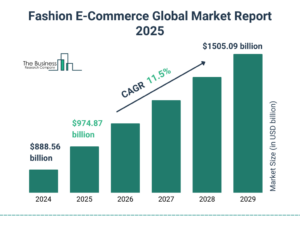
Image credit: thebusinessresearchcompany
So if you’re wondering how to build (or rebuild) your fashion business for the way people shop now, you’re in the right place. In this guide, we’ll walk you through the trends, tools, strategies, and must-knows for building a fashion eCommerce brand that looks amazing and performs well.
What is Fashion eCommerce?
Fashion eCommerce is the buying and selling of fashion products online, such as clothing, shoes, accessories, and even made-to-order items. However, it’s more than just listing products on a website.
It’s how brands build their identity, connect with customers, launch new collections, and sell around the clock. For some, it’s a direct-to-consumer model. For others, it’s a hybrid of marketplace listings, brand sites, and social selling.
It might involve styling quizzes, AR try-ons, influencer collaborations, or livestream drops. It’s fast, visual, and customer-driven, with real-time data guiding decisions every step of the way.
Whether you’re an established label or just starting out, fashion eCommerce opens the door to broader audiences, more profitable margins, and far more control over how you sell.
The Evolution of Fashion eCommerce: Offline to Online
Fashion and retail have evolved hand in hand, reflecting societal shifts and technological advancements.
The past
Physical stores were the heartbeat of fashion.
- Window displays lured in curious shoppers.
- Personal interaction was the mainstay—shopkeepers knew customers by name and preferences.
- Seasonal sales and end-of-season clearances were the most awaited shopping events.
The digital shift
The rise of the internet and smartphones changed everything.
- The 2000s saw major brands developing websites, albeit primarily for brand visibility.
- By 2010, mobile shopping apps became the rage, with virtual try-ons and instant checkouts.
- Social media platforms transformed into shopping hubs. Instagram’s “Shop Now” feature, for instance, made impulse shopping even more instantaneous.
The present and beyond
eCommerce isn’t just an alternative—it’s integral.
- Augmented Reality (AR) allows shoppers to try outfits virtually from the comfort of their homes.
- Direct-to-Consumer (DTC) models are bypassing traditional supply chains, bringing fresh-from-the-runway looks faster.
- Sustainable and slow fashion trends are gaining traction, with online platforms providing the ideal space for niche, eco-conscious brands.
In a nutshell, from tactile fabric feel in offline stores to digital swipes on screen, the evolution of fashion retail is an ode to adaptability and innovation.
Advantages of Selling Fashion Online
Diving into the digital realm of fashion sales? The horizon looks promising! Here’s why selling fashion online is a stylist’s dream come true:
- Worldwide audience – Physical stores have walls; online stores have web links. One-click can connect brands to customers from different continents and cultures.
- Open 24/7 – The Internet never sleeps, and neither does your online store. Make sales while you snooze!
- Inventory management – Efficient stock control and real-time inventory checks mean no more manual stock-taking hassles.
- Dynamic pricing – Adjust prices based on demand, competitor strategies, or exclusive flash sales, all in real time.
- Interactive shopping experience – Use videos, 360-degree views, and AR try-ons to enhance the shopping journey.
- Instant feedback – With reviews and ratings, understand your customers better and pivot where necessary.
- Eco-conscious branding – Reduce carbon footprints with e-receipts, sustainable packaging, and digital marketing instead of print.
Challenges in Fashion eCommerce
As glossy and glamorous as the world of online fashion looks, it comes with its set of trials and tribulations:
- High return rates – The inability to try before you buy can lead to sizing issues and, consequently, returns.
- Intense competition – The digital realm is crowded. Standing out requires more than just quality; it demands a unique brand voice. A quality fashion eCommerce development agency can assist with this.
- Technology dependencies – A minor glitch on the website or app can lead to cart abandonment or negative reviews.
- Digital trust issues – Ensuring secure payment gateways and winning consumer trust is vital.
- Shipping and logistics – Timely deliveries, especially during peak sale seasons, can be a logistical nightmare.
- Staying updated – The digital realm evolves rapidly. Keeping up with tech trends and consumer expectations is an ongoing task.
- Sustainability concerns – As the demand for sustainable fashion grows, showcasing authentic eco-friendly practices is crucial.
Did You Know? Nearly 30% of online shoppers abandon their carts due to website errors or slow load times.
Top Trends in Fashion eCommerce for 2025
Here’s what brands are actually leaning into right now, not trends for the sake of it, but things that are changing how fashion is bought, sold, and experienced online.
1. People want to try things on without going anywhere
No one wants to guess how a pair of jeans will fit, especially when returns are a hassle. That’s why virtual try-on tools are increasingly being offered online.
AR fitting rooms and 3D previews are appearing everywhere, from mobile apps to social media feeds. They’re not perfect yet, but they’re helping reduce returns, and shoppers like the control.
2. Selling through video is working, but only when it feels real
Live shopping used to feel gimmicky. Now, done right, it’s becoming a genuine sales driver.
Brands are ditching polished scripts and leaning into raw, unscripted demos. Think stylists walking through outfits in real-time or creators answering live questions. It feels more human and it gets people to buy without clicking away.
3. Resale isn’t just for niche brands anymore
A few years ago, second-hand meant vintage or luxury consignment. Not anymore.
Everyday fashion brands are building resale into their own platforms or partnering with others to offer pre-owned items.
Not just because it’s sustainable, but because customers now expect the option, especially younger ones.
4. AI is changing how people shop and how brands sell
Shoppers aren’t clicking around and hoping for the best. They’re getting product suggestions based on their actual habits, search intent, and even visual style.
On the brand side, AI is helping with pricing, forecasting, and merchandising decisions, not just marketing emails.
5. Social isn’t just for awareness; people buy directly
That post someone sees on Instagram? It might be the only touchpoint before they tap “buy now.” TikTok, Pinterest, and Instagram are blurring the line between browsing and buying, and shoppers don’t always end up on your site.
If you’re not making your products shoppable in-feed, you’re losing out.
6. Localised experiences matter more than global scale
You might ship internationally, but that doesn’t mean your customers feel understood. Brands that do well in new markets are the ones adapting not just language, but tone, styling, models, and even how they show size or fit. It comes down to cultural awareness.
7. Small batch is smarter than overstock
More brands are ditching massive seasonal buys in favour of smaller, quicker drops.
Using pre-orders, limited runs, and data to guide production decisions makes sense both financially and sustainably. It also makes collections feel more exclusive.
How to Build a Winning Fashion eCommerce Strategy
It’s never been easier to launch a fashion brand, but growing one sustainably? That’s a different story. Between rising ad costs, high return rates, and shoppers who expect everything yesterday, a solid strategy is your only foundation.
Here’s how the most successful fashion brands are building eCommerce strategies that go beyond good looks.
1. Start with something deeper than branding
Before you obsess over aesthetics, focus on positioning.
What does your brand actually stand for?
Are you solving a specific problem (like sizing or sustainability)?
Are you challenging a norm?
Too many brands try to be everything to everyone and end up forgettable.
Be specific. What makes you worth someone’s time and money? Answer that, and ensure it is reflected in your products, site copy, returns policy, and even your packaging.
2. Know who your customers are and how they shop
Personas are great, but you need real insights too.
Look at your data…
Who buys full-price? Who waits for a sale? Who returns often? Who buys once and disappears?
This kind of segmentation helps you speak the right language, send the right follow-ups, and avoid wasting money on the wrong messages.
3. Design mobile-first, not mobile-friendly
Most fashion traffic is mobile but many sites are still built desktop-first and shrunk down. That doesn’t cut it anymore.
Your mobile experience needs to be genuinely intuitive: fast, clean, and made for scrolling.
Navigation should be thumb-friendly ✔️
Add-to-cart buttons should be obvious ✔️
Product images should load fast and look sharp ✔️
Checkout should be fast and friction-free ✔️
Sizing info should be clear and specific ✔️
4. Stop treating product pages like placeholders
If your product page just has a photo, a size dropdown, and a button, you’re leaving money on the table.
This is your sales pitch. Show the piece in motion, on diverse models, in real-world settings. Answer common fit questions. Add social proof if it’s available. Give them a reason to click “Buy now” without needing to scroll back up.
5. Use content to build connection, not just clicks
You don’t need a blog just for SEO. What you need is content that gives people a reason to return, even when they’re not ready to buy. Think style edits, behind-the-scenes stories, how-to-wear guides, or interviews with your team. It’s about building a connection, not just traffic.
6. Don’t just run ads, plan your lifecycle
Your best customers are already on your list. Build flows that treat them accordingly. Instead of blasting generic promos, think about the journey:
What do new shoppers need to feel confident?
What makes a first-time buyer come back for a second order?
What keeps loyal customers engaged, even in slow seasons?
What makes the difference is timing and relevance. Send messages that feel useful, not just frequent.
Tools to Power Fashion eCommerce in 2025
Running a fashion eCommerce business today means managing far more than just your online store. From product drops and customer experience to shipping, personalisation, and retention, you need the right tools to keep things smooth and scalable.
While no single platform does everything perfectly, there are essential categories you’ll want to cover. Below, we’ll walk through what each tool type does, why it matters, and which platforms are commonly used in the industry.
Website & Storefront
Your eCommerce platform is the foundation of your store. It should support high-quality visuals, mobile-first design, fast performance, and simple navigation. Flexibility, integrations, and ease of use matter just as much as design.
Visual Merchandising & Content
Customers don’t just want product images; they want immersive shopping. Look for tools that help you create rich visual experiences, like 360-degree views, product videos, and virtual try-ons. This content can boost engagement and reduce return rates.
Inventory & Order Management
Inventory tools help you track stock, manage SKUs, sync across sales channels, and automate order routing. This becomes especially important when selling on multiple platforms or scaling internationally.
Personalisation & CRO
The average conversion rate for fashion eCommerce rises when shopping feels tailored. With the right tools, you can personalise product recommendations, automate retargeting, and test different layouts or messages based on user behaviour.
Email & SMS Marketing
Email and SMS continue to be major revenue drivers. The best platforms let you build automated flows, segment your audience, and connect campaigns to real purchase behaviour.
Customer Support
Today’s shoppers expect quick, helpful support, not long wait times or unanswered messages. Tools with AI-powered chat, ticketing, and automation can help resolve questions fast while still feeling personal.
Analytics & Insights
You need more than just basic traffic stats. Real analytics tools help you understand customer behaviour, track conversions, optimise product performance, and make smarter decisions based on data, not guesses.
Popular Tools for Fashion eCommerce
| Tool Category | Purpose | Popular Tools (2025) |
| eCommerce Platforms | Build and host your online store | Shopify, BigCommerce, WooCommerce |
| Visual Merchandising | Enhance product display with rich content | Stylitics, Zakeke, VNTANA |
| Inventory Management | Track stock, automate orders, sync across channels | DEAR Systems, Skubana, Linnworks |
| Personalisation & CRO | Show targeted content and optimise shopping experience | Nosto, Dynamic Yield, Convert |
| Email & SMS Marketing | Automate customer comms and drive retention | Klaviyo, Omnisend, Postscript |
| Customer Support | Offer fast, helpful support through chat or ticketing | Gorgias, Zendesk, Richpanel |
| Analytics & Insights | Understand traffic, product trends, and customer behaviour | Google Analytics 4, Glew.io, Triple Whale
|
Top eCommerce Sites to Watch in 2025
Watching how leading brands innovate can reveal real-world lessons for your own store. Here are five standout fashion sites pushing boundaries right now.
1. SSENSE
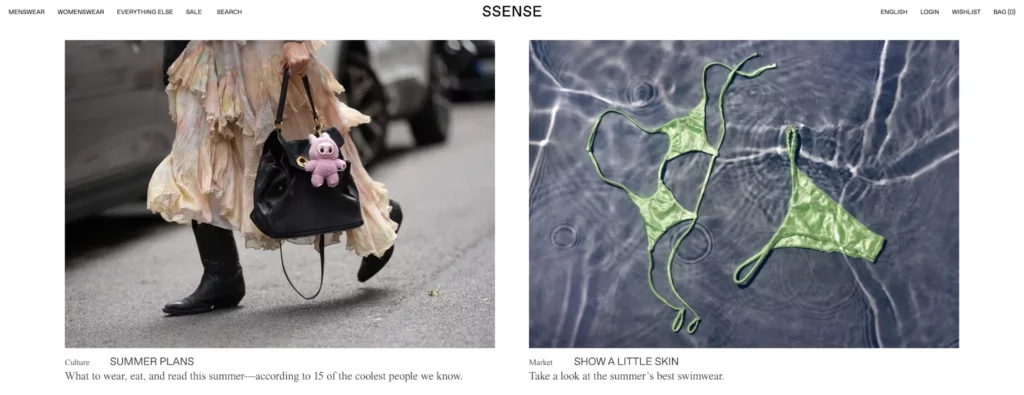
Image credit: SSENSE
A mix of high-end fashion and streetwear, SSENSE perfects the editorial-meets-shopping vibe. Clean layouts feature styled photography and clear product details, making it easy for users to browse, get inspired, and buy. Their mobile site is fast, intuitive, and visually compelling.
2. ASOS
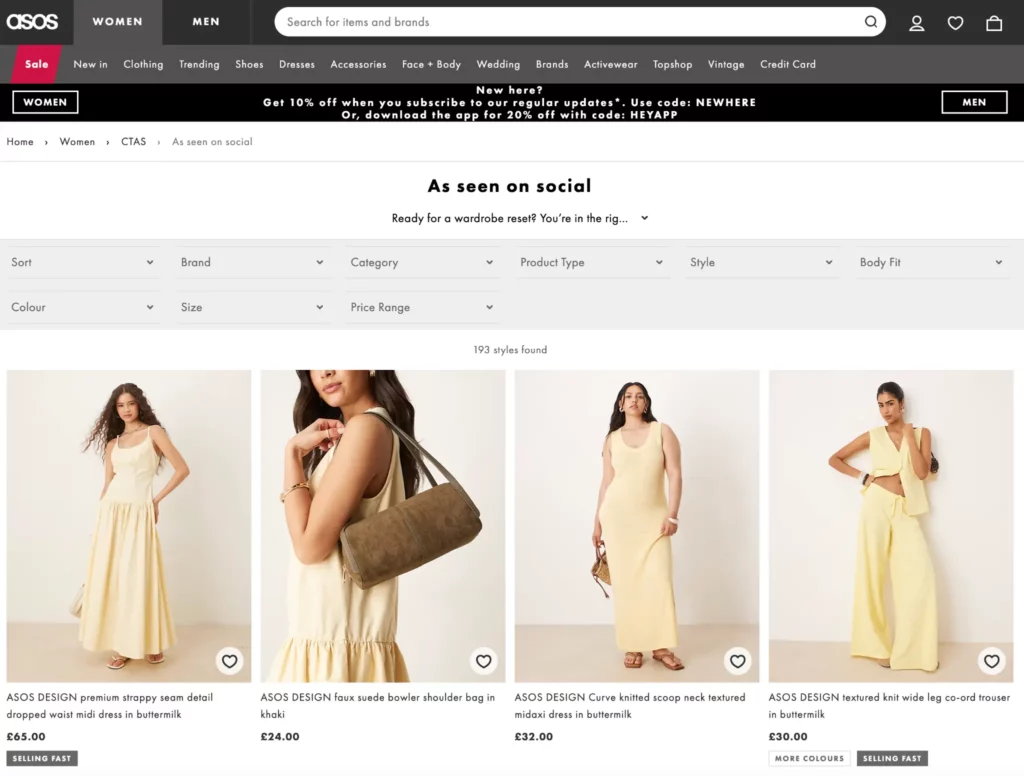
Image credit: ASOS
Still one of the strongest UK-born fashion eCommerce sites, ASOS remains mobile-first with smart personalisation baked in. In 2025, they’re leaning into AI-powered outfit suggestions, video-led styling sessions, and enhanced inclusive sizing tools… everything designed for confident, immediate purchases.
3. Farfetch
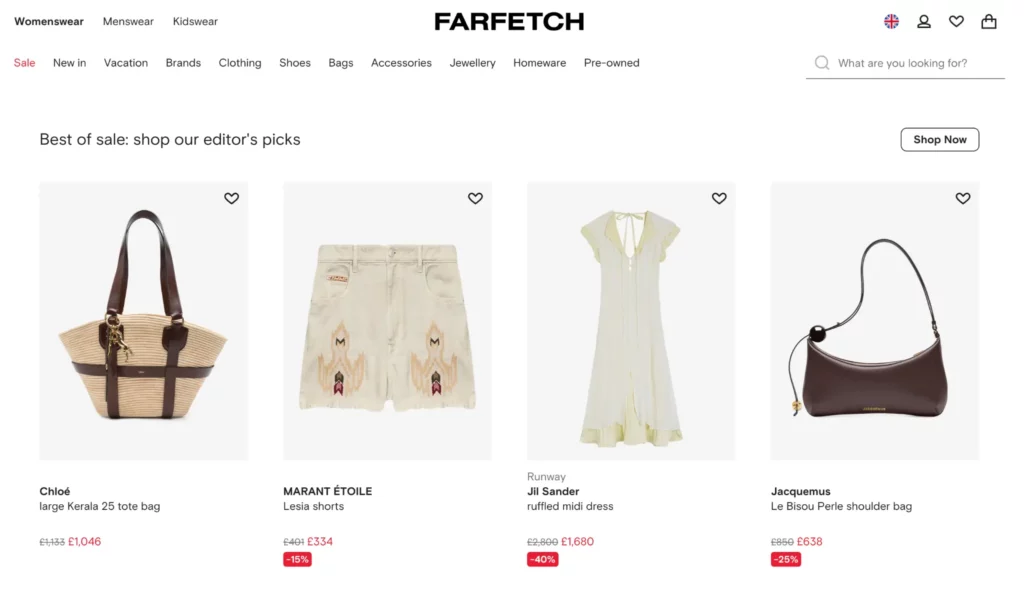
Image credit: Farfetch
Known for luxury and tech-forward retail, Farfetch excels in localisation. They adapt language, pricing, size charts, and visuals to match each market. Their integration with independent boutiques across the globe also keeps their assortment unique and culturally tuned.
4. Reformation
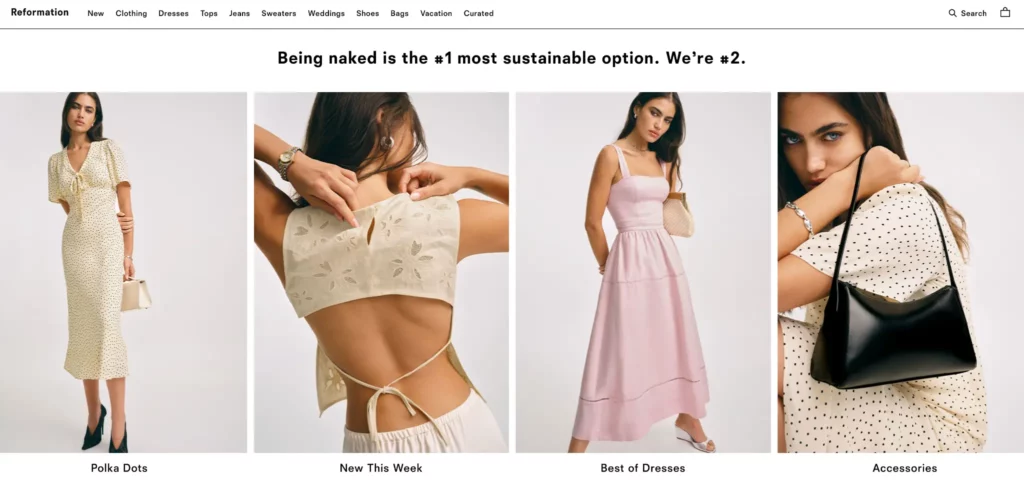
Image credit: Reformation
When sustainability matters, Reformation leads the way. Their eCommerce site goes beyond selling; each product page shares carbon footprint info, fabric sources, and eco-friendly practices. Shoppers are joining a movement, and that sense of purpose drives the conversion rate fashion eCommerce up.
5. Thaden
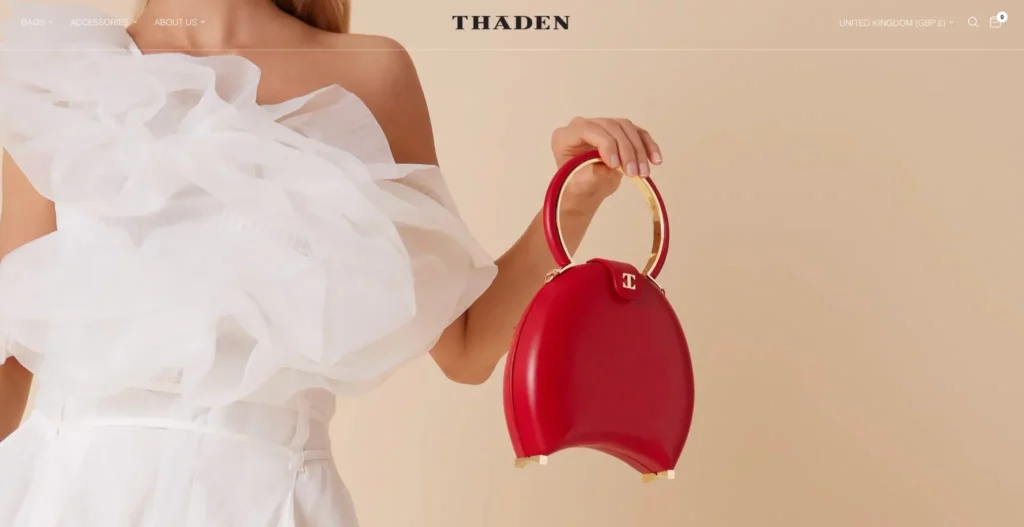
Image credit: Thaden
Thaden is a luxury handbag brand with a strong artistic identity and a mission to reflect women’s individuality through design. When launching their first collection, they needed an eCommerce experience that told their story. Appnova helped bring that vision to life by designing and developing a responsive, image-led site that highlighted every detail of the product and the brand’s ethos.
Stay Ahead in the Competitive Fashion eCommerce Landscape
One thing is for sure: the fashion eCommerce industry is thriving at the moment! You’ve got many, many brands that are fighting for attention.
Naturally, you want to make sure your brand stands out, rather than simply blending in.
So, how do you achieve this?
Well, continual learning is key. Embrace webinars, workshops, and courses that provide insights into the latest eCommerce trends.
You can also expand your reach and enhance brand credibility by forming collaborations and partnerships. Look to join forces with influential figures, bloggers, and complementary brands.
The importance of data analytics cannot be stressed enough, offering profound insights into customer behaviour and enabling you to optimise your fashion digital marketing campaigns and predict upcoming trends.
Social media is your stage; engage actively, showcase behind-the-scenes content, initiate contests, and build a loyal community.
Lastly, delivery can make or break the deal. Innovate with options like same-day deliveries, provide trackable shipping, and ensure you have a flexible return policy in place.
The Future of Fashion eCommerce
If today’s trends are any indication, the future of fashion eCommerce is set to be nothing short of spectacular.
Digital fashion shows
Virtual reality may soon transport buyers straight to front-row seats at fashion weeks around the world.
3D Printing
Customers could design and print bespoke fashion items at home.
Blockchain for authenticity
For luxury fashion, blockchain can verify product authenticity, combating counterfeits.
Subscription models
Monthly curated fashion boxes tailored to individual tastes could become the norm.
Augmented reality shopping malls
Virtual malls where customers can stroll, shop, and socialise, all in AR.
Final Recommendations for Fashion Retailers
Embracing change is essential. Both the fashion world and the digital realm are in constant flux; adaptability is the name of the game.
While selling apparel is the ultimate goal, prioritising customer experience at every step of their shopping journey can truly set you apart.
Inclusivity, be it in the form of gender-neutral clothing or catering to a range of sizes, is essential. Engaging with customers authentically, whether through newsletters, social media interactions, or web chats, can forge stronger bonds.
And never underestimate the power of technology. Investing in the right tools, from AI chatbots to efficient CRM systems, can drastically elevate your operational efficiency.
Remember, it’s not only the clothing that lures customers but also the narratives you craft and the values you uphold. So, chart your path with conviction and style.
Frequently Asked Questions
1. How do I start a fashion eCommerce business?
Starting a fashion eCommerce business begins with choosing your niche. Think about what makes your brand different, whether that’s your design style, sustainability focus, or how you solve fit and sizing issues.
From there, develop your product range and decide on a business model, like selling direct-to-consumer or through marketplaces. You’ll need to plan your supply chain, build your brand identity, and set up an online store that’s easy to use.
Once everything’s in place, you can launch your website, set up marketing channels, and start attracting your first customers.
2. What makes a good fashion eCommerce website?
A good fashion eCommerce website is mobile-friendly, fast to load, and simple to navigate. It should make it easy for customers to browse, compare, and buy without confusion or friction.
High-quality product images, detailed descriptions, clear sizing info, and easy checkouts are all essential. It also helps to have a modern design that reflects your brand and builds trust with shoppers from the moment they land on the page.
3. Which platform is best for a fashion eCommerce store?
The best platform for a fashion eCommerce store depends on your needs, budget, and growth plans. If you’re looking for something easy to set up with built-in tools, hosted platforms are a great starting point.
If you want more control and flexibility as you scale, open-source platforms or headless setups might be a better fit.
Look for a platform that supports strong visuals, integrates with marketing tools, and can handle your product range smoothly.
Subscribe To Us
Our Services
Categories
Subscribe To Us
Contributors
Categories

This website uses cookies so that we can provide you with the best user experience possible. Cookie information is stored in your browser and performs functions such as recognising you when you return to our website and helping our team to understand which sections of the website you find most interesting and useful. Third party cookies such as Google Analytics is also used on this site to provide analytics in order to better understand the user engagement on our site.
You can adjust all of your cookie settings by navigating the tabs on the left hand side.
Strictly Necessary Cookie should be enabled at all times so that we can save your preferences for cookie settings.
If you disable this cookie, we will not be able to save your preferences. This means that every time you visit this website you will need to enable or disable cookies again.







0.Comments